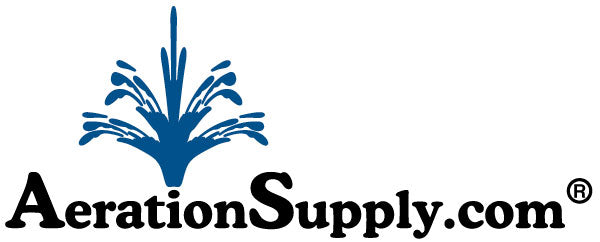Benefits Of Sub-Surface Aeration
Sub-Surface Bottom Aeration is generally desirable when a pond or lake exceeds 5' to 6' in depth. A sub-surface pond aerator for ponds and lakes is achieved by use of an air compressor mounted on shore, that "pumps" or "pushes" compressed air through a submersible airline to an air diffuser located on the bottom of the pond or lake. The diffusers simply "breaks-up" the air [diffuses air] into very small bubbles as it is forced through an EPDM rubber membrane. The rising bubbles from the bottom of the pond or lake then draws or "entrains" this oxygen depleted, "dead" bottom water towards the surface where it mixes with oxygen rich water at the air/water interface. Sub surface pond bottom aerators have been proven to effectively lift and "mix" an entire water column within a matter of hours. A large majority of our pond and lake bottom diffused aeration systems are proudly Made In The USA!
Illustration Before Installation of Sub-Surface Aeration

Illustration After Installation of Sub-Surface Aeration

Sub-surface aerators for ponds and lakes have some inherent benefits over surface type pond and lake aeration systems. Diffused aeration systems do not have electricity in the water so safety is a major benefit. These types of pond and lake aerators are used throughout the year, both summer and winter, so once installed they remain in the water. Energy consumption with lake and pond bottom aerators is often much less than larger surface type aerators. And finally, pond and lake bottom aerators are non-invasive in that their effects are not obvious at the surface but do all of the mixing below the waters surface.
When you purchase a pond and lake bottom aerator form AerationSupply.com your buying direct from the manufacturer! No middlemen here.
More about sub-surface aeration:
You need to take a variety of factors into account when you're deciding on equipment and design. These include the surface area, depth, shape, present water quality, and water source. You also need to factor in the environment the pond or lake is in and the run-off that affects it. Another important factor to consider is what the pond or lake will be used for. Is it a fish pond or a swimming pond or lake, or is it just for decoration? You have to pay attention to the goals. Are you primarily looking for the aesthetics of a floating fountain, or are they looking for water quality improvement?
We know that people need oxygen to live. We also know that plants need oxygen for healthy growth. But did you know that ponds and lakes need oxygen almost as much? That's because oxygen is vital not only to fish, but also to the ecological processes that protect water quality and keep it clear. Plants, wind, rain, waves - all of these add oxygen to the water. But sometimes these are not enough to stop a pond or lake from deteriorating. Installing an aeration system is often the best way to give a pond the oxygen it needs to maintain water quality and reduce algae.
In some climates, pond and lake aeration provides enough movement to keep the water from freezing in winter months and prevents winter fish kill by keeping the water oxygenated. Winter is a critical time for pond and lake health because a pond or lake that is frozen over is deprived of the oxygen it would normally get due to lack of sunlight penetrating the snow covered ice. Keeping a hole in the surface ensures that the pond has continued access to oxygen throughout the winter. The open water also helps provide a protected area for waterfowl. There are several types of pone and lake aerators, and choosing the right one depends on the specifications of the pond or lake itself, the conditions you are treating, and the aesthetic look a homeowner desires.
How aeration systems work:
Pond aerators work either by pumping compressed air into and through the water, or by agitating the water surface. As water moves across the surface, it grabs oxygen from the air and releases harmful gases at the same time. Using an aeration system in a pond or lake can help maintain the overall health and quality in a number of different ways. First of all, if a pond or lake contains fish, aeration is essential. Aerated ponds and lakes can support greater concentrations of fish and can literally give them more "room to breathe" by circulating water to eliminate thermal stratification. In a stratified pond, the upper, warmer layer can become oxygen saturated while the lower, bottom layer lacks oxygen. This can greatly stress fish and cause fish kill. Stirring up the layers through aeration can distribute a healthy amount of oxygen throughout the lake or pond. As the water moves around, it helps even out the temperature and the oxygen concentration." Aeration in ponds and lakes also provides the oxygen necessary for aerobic digestion of algae, ammonia, and nitrites. Bacteria aid in the decomposition of fish waste, debris, and other organic matter; adding oxygen encourages this process. This protects fish health and helps prevent dead organisms from accumulating as sludge in the lake or pond bottom. It also helps eliminate pond odors. In addition to improving the chemical balance of the pond or lake, circulating water can also push certain kinds of algae to the sides of the pond where they can be more easily removed. It can help control mosquito larvae as well, because mosquitoes do not breed as freely in moving water.
An aeration system for your pond or lake is an investment, sometimes a big one. But it can protect an even bigger investment by ensuring a long and healthy life span for the pond and the fish.
Aeration Supply, Inc Copyright© 2019
